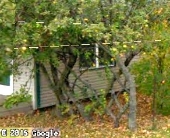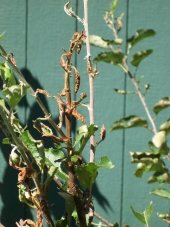












Pecan Media: food forestry and forest garden ebooks
Now available: The Native Persimmon (centennial edition)





Owner, Etta Place Cider








Ann Torrence wrote: What size tree does the package say it will be, dwarf or semi-dwarf?
 .
.
Miles Flansburg wrote:Not sure if this is it but my tree would have loads of fruit and the branches would all go from being straight to curving to the ground. After a couple of years of this it looked more like an umbrella frame.




This new variety is also characterized by a moderately vigorous tree with a slightly upright growth habit. Trees bear fruit annually and do not require chemical or hand thinning. The variety has been hardy in the field at the above-noted location at Excelsior, Minn. with trees showing little winter injury and bearing fruit annually. Laboratory freezing tests of 1-year old wood conducted in December 1986 and January 1988 compared Honeycrisp to other common varieties for cold hardiness (Chart B). Honeycrisp showed less freezing damage than regent, Honeygold and Haralson in the December 1986 test and in similar tests in January 1988 Honeycrisp showed less injury than McIntosh and Honeygold, but more injury than Regent and Harlson.




Not growing or raising anything at the moment, but I'm here doing research for the future.












Ken W Wilson wrote:Russell, are the leaves kind of folded over and kind of white and fuzzy in the fold. Spider mites are the only leaf insect problems. Fire blight is the main disease problem here.
Alice, that yellow apples sounds like a Lodi I had many years ago. Is it an early apple? I know there must be other kinds that fit that description, but it made me remember the Lodi instantly. They were really good for cooking before they're soft and ripe.











Nicole Alderman wrote:
Is there a way to prune or help the tree to get stronger limbs? I have another tree (Gravenstein) that also has pretty droopy branches, and I'd like to prevent that with this tree if I can!
Owner, Etta Place Cider








John Polk wrote:I find it hard to believe that the Honeycrisp (TM) is considered 'weak growth'.
The UMinn spent a lot of time developing that tree for their brutal winters.
Here in Washington, as older orchards are being upgraded, Honeycrisp is quite often the choice...
...they sell for at least 2X what other types do in the market here.
I cannot imagine that commercial orchards would waste their time (&$) on a weak growth tree.
I would be willing to bet that that reputation is based on the choice of rootstock.
Some root stocks do poorly on certain soils, or in certain weather situations.
This poor reputation is probably the result of people using the wrong rootstock for their site.
The Honeycrisp is my favorite eating apple - the perfect balance of Sweet/Tart, plus a wonderful crispness.
Fantastic apple in my opinion.











Owner, Etta Place Cider











 1
1




Owner, Etta Place Cider








Alice Tagloff wrote:Even fully grown, 30 year old apple trees sometimes need a trellis. Even if this trellis looks more like a support jack. We have apple trees around my hometown that are older than my grandparents, and in the recent years with the warmer weather, over produce to such an extent that the fruit threatens to snap the branches off the trees.
There's one particular tree in town that has support beams under all it's limbs, literally, 4x6's, and steel jack beams in the past few years. But these beams are only necessary when there is to much fruit on the tree, or so the owner goes about it. It's a dwarf, short tree, and one year he used a car jack to shore up the lowest limb.
The scary thing about the apple trees around my hometown is that none of them are grafted, back then, people around here took what they could get, and that was the local 'farmer' starting trees from seeds, or a bored house-wife trying to grow it for a lark. So -all- the branches on all the trees around here, flower and fruit. One of oddest trees in town is this yellow apple that just might be a honeycrisp, when the tree fruits, the apples are often grapefruit sized but extraordinarily soft, even letting it fall or grabbing it to hard will bruise it. All the other trees are some variant of crabbe apple for the most part.
As for an apple tree flowering and no fruit, a single tree is probably not a cultivar(self pollinating), you often need a second tree that's male, big box stores often have no idea what they're selling when it comes to fruit trees, and the nurseries that sell to them often don't care to have grafted branches from both trees onto the rootstock, which makes the trees more expensive. The ones you tend to get from big box stores often only have two or three branches that are grafted to bare fruit, meaning that if you want to get a full blown tree with fruit all around, you eventually have to do your own grafting. And even then, you have to get your pollinators drawn to the tree, especially if it's not 'common' in your area, they don't know what it is. My parents are now finally getting apples from their trees, and it took putting planters full of lupines between the trees to get the bees to even go near them.
What you should try to get to compliment your apple tree would be a Gage tree. Green Gage's are like a cross between a plum and a Damson. They are sweet, rich in vita-c, and heavily juicy, when you bite into a properly grown Gage, your not eating your first bite, your drinking it. Around here, there used to be some Gage's, but a tree blight resulted in almost all the Damson's and Gage's getting cut down, which is a crying shame. Gage trees originated from England, so they get to be quite frost hardy. Around here, we're about zone 3/4. Damson's are a small type of plum/grape, they're like sour-tangy prunes with large stones in them. There have been years where there's no apples because of the weather, and the Damson's -always- bear fruit. They're also frost hardy, and both types of trees lend to jam and jelly making, tho you can just bottle Gage's. Gage's and Damson's are cultivars, meaning they don't need a second tree, but all cultivars do well with something of the same type around, especially each other. The ones we had in our old homestead garden, were actually planted together(like someone had a bucket of the stone pits and just dumped them down a hole to see if they'd grow), and they grew up in a big pile of multiple trunks twined together, some years you couldn't tell one fruit from the other. Tho be warned, a well-growing Gage and Damson tree will get to around 30 feet, or something with a canopy like a Dogwood, so they need their eventual space, and they're often hard to find.

|
I'm not dead! I feel happy! I'd like to go for a walk! I'll even read a tiny ad:
Play Your Way to a Sustainable Lifestyle: Uncover Permaculture Principles with Each Card
https://gardener-gift.com/
|




